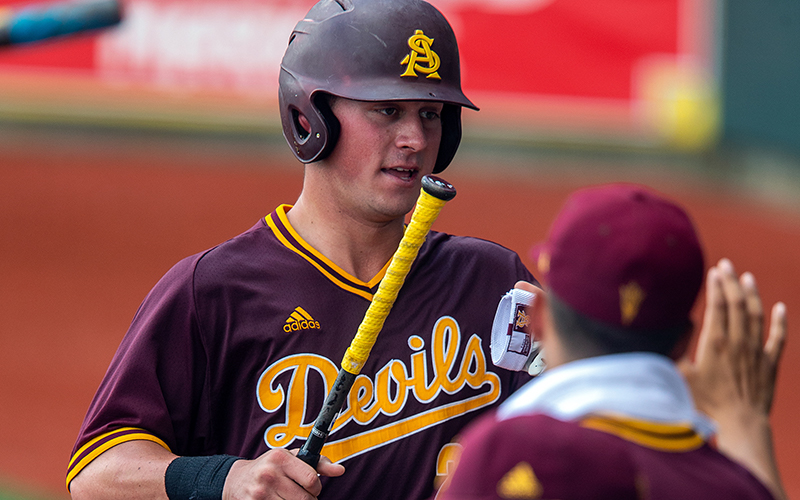
UCLA coach Chip Kelly, left, and Arizona State’s Herm Edwards have had to prepare for the 2020 football season through virtual meetings with their players. (Photo by Sean M. Haffey/Getty Images)
PHOENIX – Teaching, mentoring, planning.
Just because Pac-12 football coaches have to practice social distancing with their players, their work hasn’t stopped. The needs of their players still have to be met.
On a Zoom webinar, UCLA’s Chip Kelly, Oregon State’s Jonathan Smith and Arizona State’s Herm Edwards dished on how they’re handling the unusual challenges the COVID-19 pandemic presents.
Without having players in the building, coaches have reached out virtually to keep in touch with their teams and help return a sense of normalcy to their days.
“We get to teach a little bit more with our players,” Kelly said. “We get to spend a little bit more time with them. Even though it’s virtually, we’re still spending time with them and finding out what makes them tick, and how we can help them be successful.”
Kelly and the other coaches may soon be able to do more than teach. Several state governors, including California Gov. Gavin Newsom and Arizona Gov. Doug Ducey, have expressed support for the resumption of sporting events without fans. Pac-12 presidents and chancellors will vote this week on removing or extending the suspension of on-campus activities that runs through the end of May, which could allow players to return to campus within weeks.
The University of Louisville is welcoming athletes back starting May 27.
Southeastern Conference schools voted to allow voluntary in-person athletics activities as soon as June 8 at the discretion of each member university. The Big 12 voted to allow football activities to return June 15.
But until the conference gives the all clear to return to team facilities, Pac-12 players’ lives are less structured than they would ordinarily be. Left to their own devices, they can only rely on themselves for conditioning motivation to keep their bodies and minds in shape for a season they hope will come.
With that in mind, Edwards has encouraged his players to structure their days themselves.
“You got to make your own schedule,” he said. “And I challenge guys with that. I say, ‘You know what, this is the time that you need to reflect on you. What does your schedule look like every day? And does that schedule allow you to become a better version of yourself?'”
Edwards hopes for the best, but he, Kelly and Smith are practical about what will be necessary to return to play. All three agreed that time in their schools’ strength and conditioning programs before the season’s start will be essential for preparing their players.
“These players have to be in condition to play football,” Edwards said. “And as much as we think they’re working out on their own, they’re not in football shape. The one thing you don’t want to do is put players in a position where they’re going to get hurt.”
Kelly theorized that with properly conditioned players, teams could prepare for a season to start in less than a month.
“If our strength and conditioning coaches have them for a couple of weeks before we got them, then I think you could do it in four weeks,” he said. “That’s what they do at the other divisions. But you need to have somebody working with them.”
Smith, whose team fell one game short of a bowl trip in 2019, stressed the importance of ensuring players are in a position to compete well upon their return to game action.
“We want to put a good product out there,” he said. “We want to have enough time to be able to play quality football.”
Another area of concern was whether high school players would be able to complete their seasons in the coming fall. Edwards said this was a concern potential recruits have passed on to him, one he thought could affect recruiting.
“The thing that I’m learning probably more than anything else is a lot of these young men are worried about maybe in their area, there might not be high school football,” he said. “So kids now are committing a little early, because they might not have senior film if there’s not football.”
Edwards added that while prospects may want to commit to reserve a spot in a team’s class, reopening campuses could lead to players deciding to take more visits and reopen their recruitments.
The NCAA extended a previously instituted recruiting dead period through June 30 to protect coaches and recruits from worsening the spread of COVID-19. But new guidance from the organization’s Division I Council allows voluntary on-campus athletic activities to restart June 1, which could open the door for recruiting visits later in the summer.
Approximately 900 high school players in the class of 2021 have already committed to Division I football programs as of May 23, recruiting website 247Sports reported. Site expert Bud Elliott noted in a May 6 article that 627 class of 2021 players had committed to schools, more than double the number of committed class of 2020 recruits on the same day in 2019 (302).
This could lead to a rash of decommitments as campuses reopen, as Elliott and Edwards have surmised.
Regardless, Pac-12 coaches have plans in place to navigate their preparation for the upcoming season and the new recruiting terrain whenever the time comes.
“We’re not the ones making the decision,” Kelly said. “We’re the ones when you give us the marching orders, our plans are in place and we’re ready to go.”

